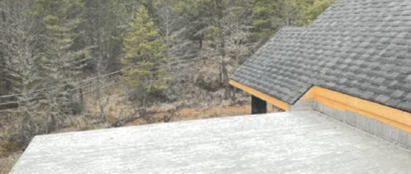BCAB 1880 - Required guard protection at intersection of deck and sloped roof
Required guard protection at intersection of deck and sloped roof
Project description
The subject is a deck, on the roof of a garage. The garage is attached to the house and the deck is approximately 3 meters above the adjacent ground. Three sides of the deck are protected by a guard. The fourth side of the deck intersects with the wall of the house at the eave. The roof is approximately 500 mm above the deck and slopes up and away from the deck at a 10 in 12 slope.

Applicable Code requirements
Sentence 9.8.8.1.(1) of Division B of the British Columbia Building Code 2018.
9.8.8.1.(1) Except as provided in Sentence (2), every surface to which access is provided, including but not limited to flights of steps and ramps, exterior landings, porches, balconies, mezzanines, galleries and raised walkways, shall be protected by a guard on each side that is not protected by a wall for the length where
a) there is a difference in elevation of more than 600 mm between the walking surface and the adjacent surface, or
b) the adjacent surface within 1.2 m of the walking surface has a slope of more than 1 in 2.
Decision being appealed (Local authority’s position)
The local authority has determined the roof cannot be considered a wall as described in Sentence 9.8.8.1.(1), and therefore a guard must be provided on the fourth side of the deck, parallel to the eave to restrict access to the roof.
Appellant's position
The appellant does not consider the Code requires a guard to restrict access to the sloping roof, that the roof is effectively the same as a wall, as it slopes up and away from the deck and is too steep to climb on.
Appeal Board decision #1880
It is the determination of the Board that the deck is not protected by a guard or a wall.
Reason for decision
The roof is neither a guard nor a wall. The intent statement below is not met.
To limit the probably of inadequate fall protection at significant changes in elevation between adjacent surfaces, which could lead to:
- Persons falling, or
- Persons falling in an emergency, which could lead to delays in the evacuation or movement of persons to a safe place.
This is to limit the probability of harm to persons.
Frankie Victor
Vice Chair, Building Code Appeal Board
